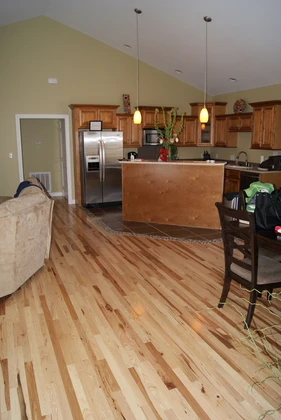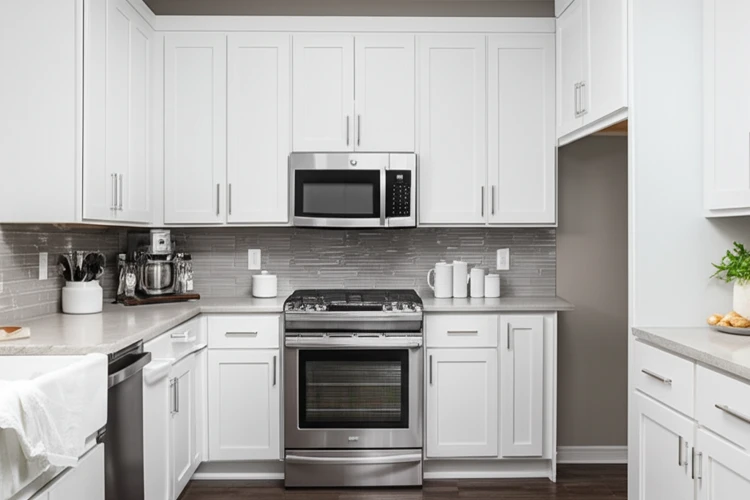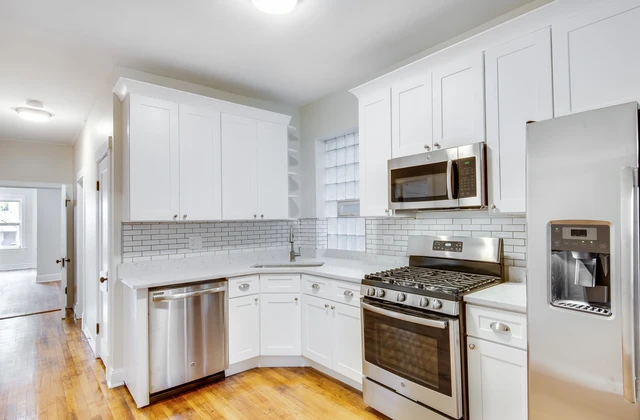Disclaimer: As an Amazon Associate, I earn commission from qualifying purchases.
The concept of open kitchen living room designs is gaining immense popularity due to their ability to create a seamless flow between spaces, enhance natural light, and foster better social interaction. Choosing the right paint colors for such designs can significantly amplify these benefits, making the space not only aesthetically pleasing but also functional.
This guide will provide expert-backed solutions and practical tips for both homeowners and renters, drawing from extensive research and practical experience in interior design and kitchen remodeling.
Benefits of an Open Kitchen Living Room Design
Open kitchen living room layouts offer numerous advantages. One of the primary benefits is the improved flow and connectivity between different areas of the home. This layout allows for better natural light distribution, making the space feel brighter and more inviting. Additionally, it enhances social interaction, as family members and guests can easily converse and engage with each other across different zones.
According to studies, homes with open floor plans tend to see a significant increase in value. For instance, a report by the National Association of Realtors indicates that open floor plans are highly sought after by modern homebuyers, adding to the home’s market appeal.
However, it’s essential to consider both the pros and cons. While open floor plans are great for social interaction, they can sometimes lack privacy and may require careful planning to avoid clutter and maintain a cohesive look.
Key Considerations for Painting an Open Kitchen Living Room
Before selecting paint colors, several key factors must be considered. The size of the space, natural light availability, and existing decor play crucial roles in determining the overall look and feel of the open kitchen living room. For example, smaller spaces may benefit from lighter colors to create an illusion of more space, while rooms with ample natural light can handle darker, more dramatic shades.
Professional tools and techniques, such as color swatches and digital renderings, can help visualize how different colors will interact with the space. Interior design principles from reputable sources like the American Society of Interior Designers (ASID) emphasize the importance of these considerations.
It’s also vital to understand the durability of different paint types. For high-traffic areas like the kitchen, semi-gloss or satin finishes are recommended for their ease of cleaning and longevity. Transparent information on these aspects ensures a well-informed decision.
Color Psychology in Open Kitchen Living Room Paint Ideas
Color psychology plays a significant role in how we perceive and interact with our surroundings. Different colors can influence mood and appetite, making it crucial to choose wisely for an open kitchen living room. For instance, warm colors like red and orange can stimulate appetite, while cool colors like blue and green can create a calming atmosphere.
Psychological studies on color impact, such as those by the University of Amsterdam, highlight how color can affect our emotions and behaviors. Industry publications on color theory provide insights into how to apply these principles in real-life scenarios. For example, using a soft blue in the dining area can create a relaxing environment, while a pop of red in the kitchen can enhance the feeling of warmth and energy.
It’s important to note that individual preferences and cultural differences can influence color perception. Therefore, while these guidelines are helpful, personal taste should ultimately guide the choice.
Neutral Paint Colors for a Timeless Look
Neutral paint colors like white, beige, and gray are versatile choices for an open kitchen living room. These colors provide a timeless look that can easily adapt to changing decor trends. White, for instance, can brighten up a space and make it feel more expansive, while beige and gray offer a softer, more grounded feel.
Drawing from the author’s extensive experience with neutral color schemes, these shades can be used to create a cohesive and timeless look. Reputable sources like Elle Decor and Architectural Digest often feature timeless design trends that incorporate neutral colors effectively.
For example, a kitchen with white cabinets and gray walls can create a clean, modern look, while a living room with beige walls and dark wood accents can offer a more traditional, cozy feel.
Bold and Vibrant Paint Ideas for a Modern Touch
Bold and vibrant colors can add a modern touch to an open kitchen living room. Using these colors strategically can create a striking visual impact without overwhelming the space. For instance, a bright yellow accent wall in the kitchen can add a burst of energy, while a deep navy blue in the living room can create a sophisticated, dramatic look.
Techniques for balancing bold colors include pairing them with neutral elements to avoid visual overload. Industry leaders like Pantone often highlight modern design trends that incorporate bold colors effectively.
However, it’s essential to consider the pros and cons of bold colors. While they can add personality and character, they may also make the space feel smaller or too intense for some. Balancing these colors with neutral tones can help achieve the desired effect without compromising the overall harmony of the space.
Accent Walls: Adding Depth and Character
Accent walls are a fantastic way to add depth and character to an open kitchen living room. By choosing a focal point and painting it in a contrasting color, you can create a visual highlight that draws the eye and adds interest to the space.
A step-by-step guide to creating an accent wall includes selecting the right wall, choosing a complementary color, and applying the paint with professional techniques. Design principles from sources like Houzz and Better Homes & Gardens offer insights into creating effective accent walls.
For example, painting one wall in a rich, deep color like forest green can add a sense of drama and sophistication, while a lighter accent wall in a soft pastel can create a more subtle, calming effect.
Textured Paint Techniques for a Unique Look
Textured paint techniques, such as sponging, ragging, and stenciling, can add a unique look to an open kitchen living room. These techniques create visual interest and depth, making the space feel more dynamic and personalized.
Comparing different techniques and providing recommendations based on the desired aesthetic is crucial. Industry publications like Fine Homebuilding and This Old House offer insights into advanced painting techniques.
For example, a sponged effect can create a soft, textured look that adds warmth and depth, while a stenciled pattern can add a more decorative, personalized touch.
Incorporating Natural Elements into Paint Ideas
Incorporating natural elements like wood, stone, and greenery into paint ideas can create a harmonious look in an open kitchen living room. These elements can add a sense of nature and tranquility, making the space feel more inviting and connected to the outdoors.
Studies on the benefits of natural elements in interior design, such as those by the Environmental Protection Agency (EPA), highlight how these elements can improve mental well-being and overall comfort. Blending natural elements with paint colors can create a seamless, cohesive look.
For example, pairing a green accent wall with wooden cabinets and potted plants can create a nature-inspired oasis, while a stone backsplash with earthy-toned paint can add a rustic, grounded feel.
Sustainable Paint Options for an Eco-Friendly Kitchen
Choosing eco-friendly paint options is crucial for an open kitchen living room, as it ensures a healthier and more sustainable living environment. Sustainable paints are free from harmful chemicals like VOCs (Volatile Organic Compounds) and are made from natural, renewable materials.
Product recommendations for sustainable paints include brands like Benjamin Moore’s Natura and Sherwin-Williams’ Harmony, which are known for their low-VOC formulations and environmentally friendly manufacturing processes. Environmental studies and industry standards, such as those by the U.S. Green Building Council, emphasize the importance of choosing eco-friendly paints.
It’s essential to provide transparent information on the cost and availability of these paints to help consumers make informed decisions.
Painting Tips for Small Open Kitchen Living Rooms
Painting small open kitchen living rooms requires careful planning to make the space feel more spacious and inviting. Using lighter colors and strategic painting techniques can help achieve this goal.
A step-by-step guide includes choosing light-reflecting colors, using vertical stripes to create the illusion of height, and incorporating mirrors to reflect light and create a sense of space. Design principles for small spaces from sources like Apartment Therapy and Real Simple offer valuable insights.
For example, painting the walls in a light gray and using white cabinets can create a bright, airy feel, while adding a large mirror can reflect natural light and make the space feel more expansive.
Maintaining and Refreshing Your Open Kitchen Living Room Paint
Maintaining and refreshing the paint in an open kitchen living room is essential to keep it looking its best. Regular cleaning, touch-ups, and repainting can help extend the life of the paint and maintain a fresh look.
A step-by-step guide includes using mild detergents for cleaning, addressing scuffs and marks promptly, and repainting every few years to refresh the space. Reputable sources on paint care and maintenance, such as those by Behr and Valspar, offer valuable tips.
For example, using a mild soap and water solution to clean walls can help remove dirt and grime without damaging the paint, while addressing scuffs and marks with a touch-up kit can keep the space looking fresh and well-maintained.
Frequently Asked Questions (FAQs)
What are the best paint colors for an open kitchen living room with limited natural light?
For spaces with limited natural light, opt for lighter colors that can brighten up the area. Light grays, whites, and pastels are excellent choices as they reflect light and create an illusion of more space. These colors can make the room feel airy and inviting, even in the absence of ample natural light.
How do I choose a paint color that complements my existing furniture?
Choosing a paint color that complements existing furniture involves considering the overall color scheme and style of the space. Start by identifying the dominant colors in your furniture and select paint colors that either match or contrast harmoniously. Using color swatches and visualizing tools can help in making an informed decision.
Can I use wallpaper instead of paint in an open kitchen living room?
Wallpaper can be a great alternative to paint, offering a wide range of patterns and textures that can add depth and character to the space. However, it’s essential to consider the pros and cons. Wallpaper can be more durable and easier to clean than paint, but it may also be more challenging to apply and remove. For high-moisture areas like the kitchen, choose wallpaper specifically designed for such environments.
How often should I repaint my open kitchen living room?
The frequency of repainting depends on several factors, including wear and tear, changes in design trends, and personal preferences. As a general guideline, consider repainting every 3-5 years to keep the space looking fresh and up-to-date. High-traffic areas like the kitchen may require more frequent touch-ups to maintain a clean and well-maintained appearance.
What tools do I need for a DIY paint job in an open kitchen living room?
For a DIY paint job, essential tools include paintbrushes, rollers, painter’s tape, drop cloths, and a ladder. Using high-quality brushes and rollers can help achieve a smooth, professional finish. Additionally, painter’s tape ensures clean lines and prevents paint from bleeding onto adjacent surfaces. Proper preparation and the right tools are key to a successful DIY paint job.
Conclusion
Choosing the right paint ideas for an open kitchen living room can significantly enhance the functionality and aesthetics of the space. By considering key factors like natural light, existing decor, and personal preferences, homeowners and renters can create a cohesive and inviting environment. This guide provides actionable, expert-backed solutions to common kitchen challenges, emphasizing the importance of personal preference and practical considerations.







